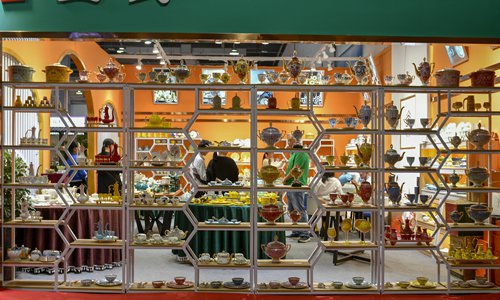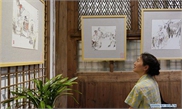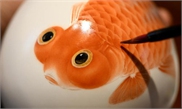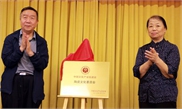SOURCE / INDUSTRIES
Reigniting porcelain traditions in Jingdezhen
The Chinese city resumes its former role as the world’s capital of ceramics

A view of a booth at the 2019 China Jingdezhen International Ceramic Fair, in Jingdezhen from Friday to Tuesday Photo: IC
Silver-haired foremen carry chunks of pinewood, stoke them in a burning brick kiln and wait patiently for the clay to become translucent porcelain. The seasoned masters drink dark tea from small pots to pass the time and remain vigilant through the night. It may take days for the kiln to finally work its wonders.
In another corner of Jingdezhen, the world's capital of ceramics, blonde-haired pilgrim potters also have hopes for the inconspicuous clay. Becca Irvin, 27, a pottery artist from North Carolina, the US, works at a private studio in an old wooden house surrounded by bamboo trees and a small ravine.
Jingdezhen is a small city in the mountains of East China's Jiangxi Province. Today, it boasts both tradition and change, and draws people from East and West.
Until Tuesday, senior foremen were working at a ceremonial re-burning of a centuries-old, gourd-shaped kiln in Jingdezhen. The ceremony was a much-acclaimed event at the 2019 China Jingdezhen International Ceramic Fair, an annual event in its 16th session. The fair attracts thousands of porcelain masters, students, experimental artists and entrepreneurs every year.
Jingdezhen's history of ceramic-making dates back over 2,000 years. Its former role as an official and royal kiln allowed its porcelain-making technique to become renowned. However, as the dynastic system fell, the city ebbed both artistically and economically. In the 1990s, it eventually lost its edge over other porcelain-making cities. In small shops, shoddily made vases and wares were branded "Jingdezhen," and were almost always on sale. The city that once prided itself on prestigious craftsmanship was overshadowed by industrial production lines that churned out impeccable cups and dishes.
In recent decades, Jingdezhen has reshaped its image. This month, a national ceramic culture inheritance and innovation pilot zone threw the city into a new spotlight. The city is mulling over new projects concerning the conservation of tradition, innovation, cultural tourism and exchange.
Tradition lives on
Cheng Guanghui, 65, is a kiln fire master. Most porcelain products are now made in gas-fired kilns with temperature-control functions, though a handful of firewood-stoked kilns exist in the suburbs of the city. For Cheng, re-firing the old kiln is of critical importance.
"If we do not fire up the old kilns, our heritage will die in our hands," he said. People favor gas kilns because they are easy, fast and guarantee a standard quality, but Cheng said the firewood kilns produce porcelains that are less predictable and have their own unique character. "Put two vases of the same size in the same position in the firewood kiln, and they will be different from one another after the burning process," he said.
Cheng and his colleagues stoke the furnaces almost every three minutes to ensure the temperature remains steady. Though the re-firing process can take days and is more ceremonial than practical, Cheng and his colleagues enjoy the experience.
Jingdezhen's efforts to conserve tradition, like using the firewood kilns, have been a success. Since 2009, 10 classic types of old kilns have been re-burned. The city now has 393 city-level intangible heritage masters, 10 of whom hold national accreditations.
In the heart of Jingdezhen, a royal kiln remains the soul of the city. Royal mandate demanded the best quality, in the most beautiful patterns and perfectly shaped. "Royal kilns made porcelain regardless of cost. Workers usually made four to 10 copies, but only shipped the best one to the emperor, and smashed up the rest. So, to this day, we have thick layers of potsherds in the ground," said Fu Hongsong, a docent of the royal kiln site. Archaeologists and porcelain researchers are sorting and studying the potsherds.
In areas surrounding the royal kiln, a large-scale restoration project is underway. "When the project is finished, Jingdezhen's heritage will be more visible, and this place will be more beautiful," said Fu.
Over the next five years, dilapidated houses in a 13-square-kilometer area will be repaired and restored to their original appearances. The project is expected to cost around 5 billion yuan ($714 million), said Liu Zili, board chairman of Jingdezhen Ceramic Culture Tourism Group, a state-owned company that is undertaking the renovation and development.
"We need to protect the physical space of history because there is a tremendous amount of information in it. And we need to pass down our cultural heritage, because that is the soul of the city," Liu said.
Shared culture
Liu, in his 50s, describes Jingdezhen as a city of migrants. His father came to Jingdezhen from Central China's Hunan Province in the 1950s. "The most distinctive feature about Jingdezhen is its uninterrupted passing-down of tradition. It is a fertile land of ceramics that never fails to attract," he said.
According to government statistics, about 150,000 people, roughly a fourth of the city's downtown population, work in the porcelain industry. Every year, about 30,000 migrants, called jingpiao, live in the city, including 5,000 from overseas.
Jiao Mengtian lived in the US for several years before coming to Jingdezhen. "When I began to develop an interest in ceramics, I thought I should come to see its origin. I'm particularly interested in colored glaze work. The colors are extremely bold and powerful," he said.
"Ceramics embrace change. I'm here to learn the tradition, and then create my own works," he said.
Jingdezhen has drawn up special plans for the construction of a pilot zone to attract talent from both home and abroad, said Chen Ying, an official with the city's talent bureau. "Talent will have to be the main driving force if Jingdezhen is to move ahead, so the city is putting a lot of efforts into this," he said.
Today, Jingdezhen is a thriving center of cultural exchange. At the city's landmark Taoxichuan, an industrial heritage complex, about 200 overseas pottery artists presented their signature pieces during the autumn fair. The red-bricked buildings have served as incubators for aspiring students, independent artists, entrepreneurs and merchants over the years. In 2018, Taoxichuan reported 101 million yuan in revenue, up 36 percent year on year.
International perspective
Tea sets, dinner wares and vases made in Jingdezhen used to be highly coveted luxury commodities in the Western world. Jingdezhen was once a symbol of worldwide trade, and it is ready to resume a bigger role in international cultural exchange.
Blue-and-white porcelain is the signature product of Jingdezhen. At the fair, Simon van Oosten from Delft, the Netherlands, exhibited his painting skills on the distinctive porcelain. In the 17th Century, with the arrival of porcelain from China, workers in Delft began experimenting with the blue-and-white patterns.
"Even today, the level of skill of the Chinese porcelain makers is very impressive," said Van Oosten, head of decoration of Heinen Delfts Blauw, a Dutch porcelain company.
At the Sanbao International Ceramic Village, Annie Long from Byron Bay in Australia works on a clay structure. "Jingdezhen attracts me because of the whole sense of a long history in one place," she said.
"I'm used to working in a studio in which I do every step, but here, people rely on each other to finish the steps," she said.
Long and Becca Irvin are both comfortable in the land of ceramics, though they do miss a few home comforts. "I would be glad to see more coffee places here," Irvin said.



